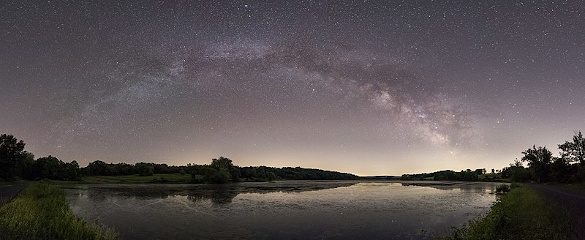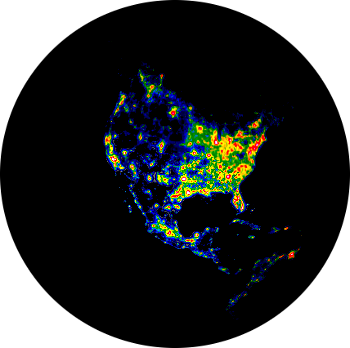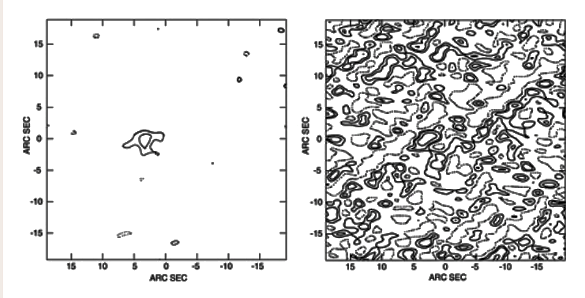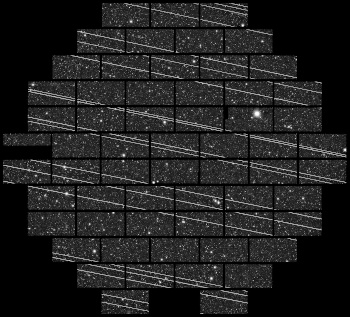LEOS
November 23, 2020
Our distant
ancestors were closer to
nature than most people living today. Because of
outdoor lighting,
urbanites are especially deprived of a clear view of the
night sky. The
Milky Way, a common sight just a few
centuries ago, is not visible to much of the
world's population. It's estimated that a third of
humanity, including nearly 80% of
North Americans and 60% of
Europeans, can't view the Milky Way.[1]

A panorama of the Milky Way as seen over Bontecou Lake, Dutchess County, New York. Bontecou Lake is in the Mid-Hudson Region of the Hudson Valley, about 80 miles north of New York City and its light pollution. (Wikimedia Commons image by Julian Colton.)
A major contributor to
light pollution is
sodium vapor lamp street lighting, in which an intense yellow-orange
spectral lines of
sodium vapor (actually a
doublet at 588.9950 and 589.5924
nanometers) is
excited in a
plasma. These lines, called the
sodium D-lines, are the basis of the sensitive
flame test for sodium used by
chemists.
Since the light emission from such street lights is concentrated at these
optical wavelengths, their
interference with astronomical imaging is mitigated by
astronomers' use of o
optical filters. Sodium vapor street lighting has been superseded by much more
energy efficient LED lighting. Although it's easier to craft LED fixtures that direct their light downward, where it's needed, rather than upwards towards the sky, the spectrum of most such lighting makes it more difficult to filter.[2]

Map of North American light pollution created by the US National Oceanic and Atmospheric Administration. Bright regions are correlated with high population density.
As I remarked in an earlier article (Light Pollution, February 4, 2013), there's also a correlation between a country's night illumination and its economic development.
While Japan and South Korea show strong illumination on such maps, North Korea is essentially dark.
(Map from the NOAA website.[3])
A sparsely populated
island is great place to site an
observatory away from light pollution. The
Roque de los Muchachos Observatory (ORM) is located in the
Canary Islands, a group of
Spanish islands in the
Atlantic Ocean about 60
miles (100
kilometers) west of
Morocco. This observatory is second only to the
Mauna Kea Observatory,
Hawaii, for clear
optical and
infrared astronomy in the
Northern Hemisphere. While suitably isolated from mainland light pollution, the islands are still inhabited by about two million people. The island of
Tenerife, which also hosts the
Teide Observatory, is home to nearly a million people, and it's about about 85 miles from ORM.
Spain has a
Law for the Astronomical Quality of the Instituto de Astrofísica de Canarias (IAC) Observatories that requires municipalities in northern Tenerife, and on the
island of La Palma where ORM is located, to control their light pollution.[1] In one case, the Tenerife city of
Puerto de la Cruz is replacing most of its
street lights with
LED lights that have
optics that
filter out blue light and direct their light downwards.[1] Blue light creates a form of light pollution known as
sky glow.[1]
Astronomy has benefited from the
Space Age through its many
space observatories, of which the
Hubble Space Telescope is the best known. The same space
technology that enables such observatories has also produced a few problems. While the occasional streaks of light from early
satellites and
spacecraft annoyed optical astronomers, there was a greater threat to
radio astronomers.
orbiting radio frequency sources, such as
Direct broadcast satellites, contain powerful
radio transmitters that beam
signals down to Earth. As early as 1960 it was realized that there would be interference from
out-of-band and spurious signals, as well as the direct signals, from these transmitters.[4]

An example of radio frequency interference on a radio astronomical observation. These data are for the same OH/IR star observed at 1612 MHz by the Very Large Array. An Iridium satellite was about 22 degrees from the star in the right image. (Image from fig. 4.1 of Ref.4, used with permission of Prof. Gregory B. Taylor, University of New Mexico.)
Things have become significantly worse for astronomers with the recent launches of multiple
low Earth orbit satellites (LEOS) into large
Satellite constellations to provide
low-latency satellite internet to remote regions not connected by
high speed cable. While such connection has been of great benefit to many people,[5] this large population of satellites has caused alarm among both optical and radio astronomers.[6-10]
The
International Astronomical Union (IAU) expressed concern about the threat to astronomy by constellations of communication satellites in June, 2019.[9] Such satellites reflect
sunlight and they create bright streaks on astronomical
images that interfere with astronomical observations.[6] These streaks are worst in the hours around
sunset and
sunrise when the satellites are not yet
shadowed from the
Sun by the Earth.[6] The number of illuminated satellites when the Sun is 18 degrees below the
horizon would approach a thousand, with the numbers decreasing as night progresses.[9]
The problem will only become worse, since there will be tens of thousands of satellites launched in the coming years to provide broadband Internet globally.[6]
SpaceX (Hawthorne, California) has already launched more than 650 of its planned 12,000
Starlink satellites.[6]
London-based
OneWeb plans a constellation of 48,000 satellites.[6] The
Amazon Kuiper Systems has US-government approval to launch 3,236 satellites.[6] Satellites orbiting at elevations more than 600 kilometers will cause a major problem, since they are sunlit longer, and OneWeb's planned constellation orbiting at 1,200 kilometers is in this category.[6]
Estimates are that the trails of constellation satellites will be bright enough to
saturate detectors on large telescopes.[9] The International Astronomical Union notes that there are no internationally agreed rules or guidelines on the brightness of orbiting man made objects.[6,9] However, satellite operators are aware of the problem, and SpaceX, creator of the Starlink constellation and the first company to start launching such satellites, has been at the forefront of
mitigation strategies.[6] When the Starlink constellation is complete, it will have about 12,000 satellites, hundreds of which will be visible at a time.[6]

Starlink satellites were imaged shortly after launch in November, 2019, with a 4-meter telescope at the Cerro Tololo Inter-American Observatory by astronomers Clara Martínez-Vázquez and Cliff Johnson.
The tiling effect is caused by gaps between CCD imaging chips.
(NSF National Optical-Infrared Astronomy Research Laboratory/CTIO/AURA/DELVE image, released under a Creative Commons License. Click for larger image.)
SpaceX has tried several things to reduce Starlink satellite visibility, such as changing the
orientation the satellites so they direct less reflected sunlight to the ground. They even
painted one satellite black, but that disturbed the
thermal management of its electronics.[6-7] Presently, the satellites are fitted with a
sunshade that blocks sunlight from reflecting from their
antennas, which are the main sources of light.[6-7]
Satellite constellations can interfere with radio telescope signals. While such telescopes as the
Square Kilometre Array in
South Africa are in a
radio-quiet zone that forbids radio emitters such as
cellphones, it isn't protected from the thousands of radio-emitting satellites.[10] Of main concern are the range of frequencies used to detect
organic molecules and
water in space.[10] Starlink satellites emit in a frequency range of 10.7-12.7
gigahertz, and its predicted that molecules such as the
amino acid,
glycine, will soon be beyond detection.[10] Although the
International Telecommunication Union has reserved some frequencies for radio astronomy, modern radio telescopes now operate over most of the frequency spectrum.[10]
Tony Beasley,
Director of the
National Radio Astronomy Observatory, is quoted in
Science as saying,
"SpaceX is legally transmitting inside one of their bands and there are going to be impacts for anyone trying to do radio astronomy... These spectrum allocations represent the goals and intent of society. We make [them] to enable commerce and to enable defense and all kinds of activities. We have to come to a solution that satisfies all these to some extent."[10]
References:
- Mark Halper, "Canary Islands installs street lights that protect night skies," LEDs Magazine, July 31, 2018.
- Lamp Spectrum and Light Pollution, Flagstaff Dark Skies Coalition.
- Light Pollution - Artificial Sky Brightness, National Oceanic and Atmospheric Administration Web Site.
- Handbook of Frequency Allocations and Spectrum Protection for Scientific Uses (2007), Chapter: 4 Technical Aspects of Protection for the Scientific Use of the Radio Spectrum, The National Academies Press, Washington, DC., https://doi.org/10.17226/11719.
- Eric Ralph, "SpaceX Starlink aids Native American tribe: 'It catapulted us into the 21st century'," Teslarati, October 8, 2020.
- Alexandra Witze, "How satellite ‘megaconstellations’ will photobomb astronomy images," Nature News,August 26, 2020, doi: 10.1038/d41586-020-02480-5.
- Anthony Tyson and Joel Parriott, "Dark skies and bright satellites," Science, vol. 369, no. 6511 *September 25, 2020),, p. 1543, DOI: 10.1126/science.abe8973.
- C. Walker, et al., "Impact of Satellite Constellations on Optical Astronomy and Recommendations Toward Mitigations," Bulletin of the American Astronomical Society, vol. 52 (2020), https://doi.org/10.3847/25c2cfeb.346793b8.
- Understanding the Impact of Satellite Constellations on Astronomy, International Astronomical Union Press Release iau2001, February 12, 2020.
- Daniel Clery, "Starlink already threatens optical astronomy. Now, radio astronomers are worried," Science, October 9, 2020.
Linked Keywords: Ancestor; nature; outdoor lighting; urban area; urbanite; night sky; Milky Way; century; centuries; world population; humanity; North America; North Americans; Europe; Europeans; panorama; Bontecou Lake; Dutchess County, New York; Mid-Hudson Region of the Hudson Valley; New York City; light pollution; Wikimedia Commons; Julian Colton; sodium vapor lamp; street lighting; spectral line; sodium; vapor; doublet state; nanometer; excited state; plasma (physics); Fraunhofer lines; sodium D-lines; flame test; chemist; visible spectrum; optical; wavelength; interference with astronomical imaging; astronomer; filter (optics); optical filter; energy conversion efficiency; energy efficient; LED lamp; LED lighting; Map; North America; US National Oceanic and Atmospheric Administration; correlation and dependence; correlated; population density; country; economic development; Japan; South Korea; North Korea; NOAA website; island; observatory; Roque de los Muchachos Observatory; Canary Islands; Spain; Spanish; Atlantic Ocean; mile; kilometer; Morocco; Mauna Kea Observatory; Hawaii; visible-light astronomy; infrared astronomy; Northern Hemisphere; Tenerife; Teide Observatory; island of La Palma; Puerto de la Cruz; sky glow; Space Age; space observatory; Hubble Space Telescope; technology; satellite; spacecraft; radio astronomy; radio astronomer; orbit; orbiting; radio frequency; satellite television; direct broadcast satellite; radio transmitter; signal (electronics); out-of-band; radio frequency interference; radio astronomical observation; data; stellar classification; OH/IR star; MHz; Very Large Array; Iridium satellite; degree (angle); Prof. Gregory B. Taylor; University of New Mexico; low Earth orbit satellite; LEOS; satellite constellation; network delay; latency; satellite internet; internet access; high speed cable; International Astronomical Union (IAU); sunlight; image; sunset; sunrise; shadow; shadowed; Sun; horizon; SpaceX (Hawthorne, California); Starlink satellites; London; OneWeb; Amazon.com; Kuiper Systems; saturation current; saturate; photodetector; detector; mitigation; strategy; rocket launch; meter; optical telescope; Cerro Tololo Inter-American Observatory; tile; tiling; charge-coupled device; CCD imaging chip; NSF National Optical-Infrared Astronomy Research Laboratory/CTIO/AURA/DELVE; Creative Commons License; orientation (geometry); painting; painted; thermal management (electronics); space sunshade; antenna (radio); Square Kilometre Array; South Africa; radio-quiet zone; mobile phone; cellphone; organic compound; organic molecule; water; gigahertz; amino acid; glycine; International Telecommunication Union; Tony Beasley; Director; National Radio Astronomy Observatory; Science (journal); law; legally; radio spectrum; band; frequency allocation; spectrum allocation; society; commerce; defense (military).